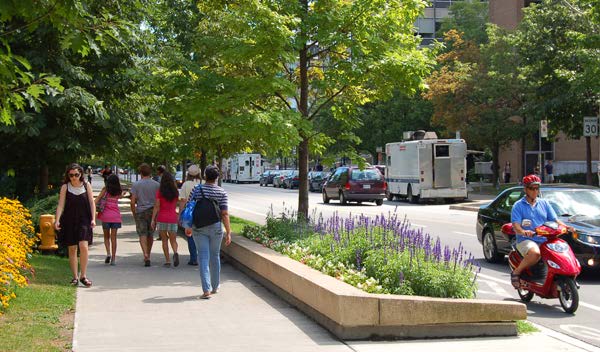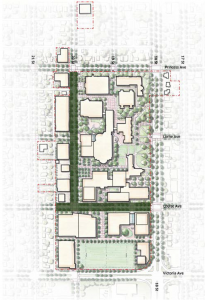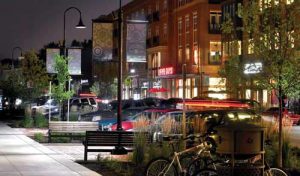Streetscapes

Streets are not just movement corridors. They are public places, and as such, are an integral component of the Open Space Framework. They function similar to the Green Linkages in that they provide attractive green connections to places throughout the Campus and beyond. They are opportunities to enhance and strengthen linkages to other University properties such as the Fleming School site and the BU Downtown Campus. They also function as Plazas, as places to walk, cycle, sit, linger, read, and wait for a bus. They are destinations and gathering spaces that allow for spontaneous interaction, planned programs and events. Importantly, they also help to define how people experience, move through, and use the campus with ease and comfort.
Policies:
- Streets should be designed to function as pedestrian-priority spaces, while accommodating all modes of transportation including bicycles, cars, buses, and service vehicles.
- Traffic speeds should reduced along internal campus streets and physical measures to mitigate traffic should be integrated in the streetscape design. Such measures include raised crosswalks, signage, street trees and landscaping, parking bump-outs, on-street parking, and enhanced paving materials such as brick or stone.
- Streetscape design should create welcoming, beautiful, and comfortable places to walk in all seasons.
- Streets should have generous sidewalks, attractive landscaping, street trees, and lighting for both pedestrians and vehicles.
- Streetscape design should incorporate attractive signage to assist wayfinding within the Campus, to neighbouring University properties, and to satellite properties such as the Fleming School site and the BU Downtown Campus.
- Opportunities for storm water management should be integrated in the streetscape design such as rain gardens and bio-swales.
- Sustainable design approaches should be used for the planting of street trees such as tree trenches and soil cells.
- 9Tree species with large canopies should be chosen to create shade, to act as wind breaks, and to increase the overall tree canopy for the neighbourhood. Trees should be limbed up to provide 6-8 metres clearance under the canopy for clear visibility and sight-lines along the street and into the campus.


